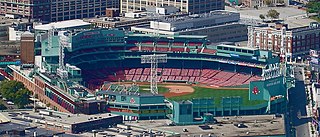
Fenway–Kenmore is an officially recognized neighborhood of Boston, Massachusetts. While it is considered one neighborhood for administrative purposes, it is composed of numerous distinct sections that, in casual conversation, are almost always referred to as "Fenway", "the Fenway", "Kenmore Square", or "Kenmore". Furthermore, the Fenway neighborhood is divided into two sub-neighborhoods commonly referred to as East Fenway/Symphony and West Fenway.

Chestnut Hill is an affluent New England village located six miles (9.7 km) west of downtown Boston, Massachusetts, United States. Like all Massachusetts villages, Chestnut Hill is not an incorporated municipal entity. Unlike most Massachusetts villages, it encompasses parts of three separate municipalities, each located in a different county: the town of Brookline in Norfolk County; the city of Boston in Suffolk County, and the city of Newton in Middlesex County. Chestnut Hill's borders are roughly defined by the 02467 ZIP Code. Chestnut Hill is not a topographical designation; the name refers to several small hills that overlook the 135-acre Chestnut Hill Reservoir rather than one particular hill. Chestnut Hill is best known as the home of Boston College, part of the Boston Marathon route, as well as the Collegiate Gothic canvas of landscape architect Frederick Law Olmsted.

The Knickerbocker Hotel is a hotel in the Yankee Hill neighborhood of downtown Milwaukee, Wisconsin. It was built in 1929 as an eight-story residential apartment hotel. In 1988 it was listed on the National Register of Historic Places.

The Duke Ellington House is a historic residence at 935 St. Nicholas Avenue, in Manhattan, New York City. Apartment 4A in this apartment house was the home of Duke Ellington (1899-1974), the noted African American composer and jazz pianist, from 1939 through 1961. It was listed on the National Register of Historic Places as a National Historic Landmark in 1976.

The Bunker Hill School is a historic school at 68 Baldwin Street in the Charlestown neighborhood of Boston, Massachusetts. Built in 1866, it is a prominent local example of Second Empire architecture, and a surviving example of the city's school planning in the post-Civil War period. Now housing residential condominiums, it was listed on the National Register of Historic Places in 1987.

The George W. Loomer House is a private residence located at 71 West Hancock Street in Midtown Detroit, Michigan. It was listed on the National Register of Historic Places in 1994.

The Milner Arms Apartments, originally known as the Hotel Stevenson, is a high rise building located at 40 Davenport Street in Midtown Detroit, Michigan; it was listed on the National Register of Historic Places in 1997. It is adjacent to, but not part of, the Cass-Davenport Historic District.

The Cass Park Historic District is a historic district in Midtown Detroit, Michigan, consisting of 25 buildings along the streets of Temple, Ledyard, and 2nd, surrounding Cass Park. It was listed on the National Register of Historic Places in 2005 and designated a city of Detroit historic district in 2016.

The Worthy Hotel is an historic hotel at 1571 Main Street in Springfield, Massachusetts. Built in 1895 and advertised as "Springfield's leading commercial and tourist house," the Worthy Hotel was Springfield's finest hotel until the opening of the Hotel Kimball in 1911. Located only two blocks south of Springfield Union Station and featuring 250 rooms, the Worthy Hotel's period of greatest significance was from 1895-1925. It was added to the National Register of Historic Places on February 24, 1983. It is historically significant not only for its commerce but for its Renaissance Revival architecture. Currently, the Worthy Hotel is an apartment building.

The Olmsted-Hixon-Albion Block is a historic commercial block at 1645-1659 Main Street in the South End of downtown Springfield, Massachusetts. The building is actually three separate 19th-century buildings that were conjoined by internal connections in 1929, making a good example of adaptive reuse of commercial architecture in the city. The building was listed on the National Register of Historic Places in 1983.
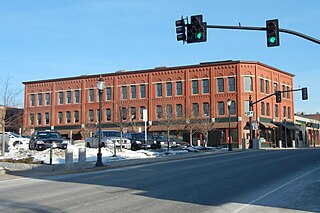
The Masonic Block is an historic commercial block at 600-622 Main Street in Reading, Massachusetts. This three story brick building is distinctive in the town for its Renaissance Revival styling. It was built in 1894 by the local Reading Masonic Temple Corporation, and housed the local Masonic lodge on the third floor. The building was listed on the National Register of Historic Places in 1984.

The Twinehurst American Optical Company Neighborhood is a residential historic district in Southbridge, Massachusetts. It consists of seven three family houses built by the owners of the American Optical Company to provide housing for their workers. The district was listed on the National Register of Historic Places in 1989.
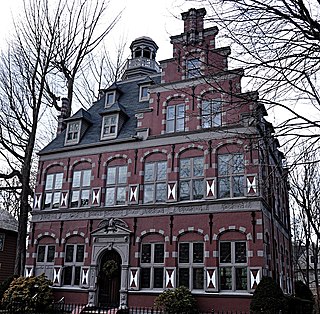
The Dutch House is a historic multi-unit residential building at 20 Netherlands Road in Brookline, Massachusetts. This four-story brick building was originally built as an exhibition hall at the 1893 World's Fair in Chicago, where it served as the Dutch Cocoa House. It is a close copy of the Franeker City Hall in Franeker, Netherlands. The door frame, embellished with stone animals, is a replica of the Enkhuizen Orphanage. The building's interior is highly ornate, with massive ceiling beams and Flemish wooden panels. The original dining room included classic blue and white Delftware tiles, some more than 300 years old. The exterior has a high mansard roof that extends over two floors, and has stepped gables. The windows include more than 12,000 individual lights of leaded green glass.

Reservoir Park is a historic park on Boylston Street in Brookline, Massachusetts. Its principal feature is Brookline Reservoir, formerly an element of the public water supply for neighboring Boston. The reservoir was built in 1848 as the main terminus of the now-defunct Cochituate Aqueduct, which delivered water from Lake Cochituate in the western suburbs. The reservoir covers 21.1 acres (8.5 ha), and is roughly kidney-shaped. A gravel path extends around the perimeter of the reservoir. The park is bounded on the north by Boylston Street, on the west by Lee Street, on the south by Dudley Street, and on the east by Warren and Walnut Streets.
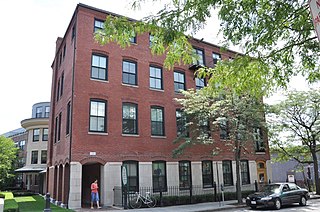
The Ritchie Building is a historic industrial building at 112 Cypress Street in Brookline, Massachusetts. Built in 1883 by Edward Samuel Ritchie, it is a fine example of the Panel Brick style, and is further notable as the factory space in which Ritchie manufactured a nationally distributed line of navigational instruments. The building was listed on the National Register of Historic Places in 1985.
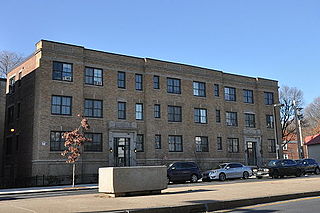
The Almont Apartments are historic apartment houses at 1439-43 and 1447-51 Blue Hill Avenue in the Mattapan neighborhood of Boston, Massachusetts. Built in 1926, they are well-preserved examples of Colonial Revival architecture, built during a period of growth fueled by the city's expanding streetcar network. The apartments were listed on the National Register of Historic Places in 2014.
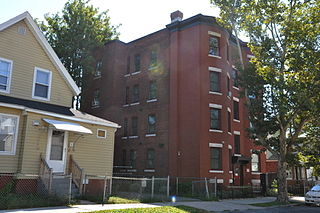
The Adams Apartment Building is a historic eight-unit apartment building at 71 Adams Street in the South End of Springfield, Massachusetts. Built in 1912, it is a well-preserved local example of Classical Revival architecture. The building, which suffered significant damage in the 2011 Springfield tornado and has been restored, was listed on the National Register of Historic Places in 2015.



























